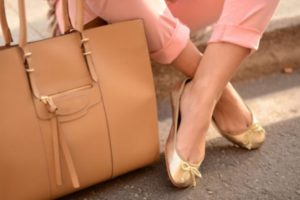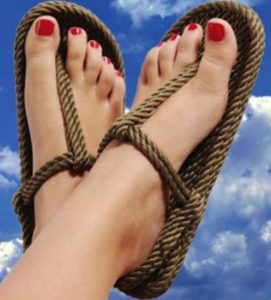In summer and early autumn you want to flutter around, but swelling can make adjustments to your plans. To avoid getting tired after 1-2 hours and starting to rush home with all your might, pay due attention to the choice of shoes. It will help reduce discomfort from swelling, avoid pain and complete all the tasks planned for the day.
What shoes are recommended for these feet?
Severe swelling along with an excessively high arch, ingrown toenails, protruding big toe, flat feet, excessively wide calves and shins is a condition that requires the use of special shoes. It must be performed in accordance with orthopedic recommendations. Examples of such recommendations:
 Insoles. Must support the arch well and have an uneven thickness, which corresponds to the anatomical features of the foot.
Insoles. Must support the arch well and have an uneven thickness, which corresponds to the anatomical features of the foot.- Heel. If you have edema during pregnancy, it is better to refrain from wearing high-heeled shoes, but for everyone else, a small heel, literally 2-5 cm, is recommended.If your legs get tired even from it, but you want to add height and visually elongate your figure, then at your service are models with a neat platform (a high one can also cause discomfort).
- Color. Dark materials absorb more heat rays than light ones. To feel at ease and avoid overheating, wear light-colored shoes.
- Size. When purchasing shoes, they must fit freely on the foot.
You need to avoid summer sandals and shoes with weaving and ropes (they will cut in), shoes out of season (the feet should not be hot, otherwise the problem with swelling will only worsen), models with platforms and high heels (it is difficult to wear even with absolutely healthy legs, so try to give preference to traditional heels and platforms).
Shoes that won't cause discomfort
The length of the tops of boots is a sore point for those who have swollen feet. There is a risk of not fastening the lock due to swelling that develops in the evening. At the same time, short boots that barely reach the calf are also not a way out of the situation.
 On the one hand, the lower part of the leg is also capable of significantly increasing in size, and therefore there is no guarantee that after a working day it will be possible to zip up. On the other hand, shoes that rise up to the beginning of the calf can easily emphasize the difference between the ankle and the top, as well as visually enlarge the open part of the leg. The gap between the knee and calf changes especially visually.
On the one hand, the lower part of the leg is also capable of significantly increasing in size, and therefore there is no guarantee that after a working day it will be possible to zip up. On the other hand, shoes that rise up to the beginning of the calf can easily emphasize the difference between the ankle and the top, as well as visually enlarge the open part of the leg. The gap between the knee and calf changes especially visually.
A way out could be to purchase
- boot (there are models that look very neat and appropriate even in combination with a skirt);
- moderately high - knee-length - boots with a fairly wide top;
- sports shoes (sneakers with uneven sole thickness are more suitable than completely flat sneakers).
Important! Pay attention to loafers, moccasins, topsiders, slip-ons, Chelsea, and Oxfords. Among the proposed options, there is sure to be a solution suitable for you.
Also useful before purchasing check the elasticity of the material from which the shoes are made. Genuine leather stretches, suede and nubuck are less deformed. Man-made leather substitutes are more likely to rip and crack or come apart at seams or zippers rather than stretch. There are exceptions to this rule, but is it worth the risk?
Important! Buy well-stitched shoes. Only she can withstand the load of swollen and tired legs.
When choosing a pair for autumn, do not forget to pay attention on the toe. This is necessary because the fingers are also susceptible to swelling. If you don’t want to cause yourself unnecessary discomfort and don’t rush to become familiar with the problem of ingrown nails, then Buy boots, boots and shoes with round, square or completely round toes.
Features of choice
 Ideally you need go to the store in the evening when swelling has reached its maximum. However, by this time, your legs may hurt so much that not only shopping, but even the slightest activity will seem like torture. That's why You should go shopping in the afternoon. If the problem is not so severe and your health allows it, then feel free to follow the common recommendations and visit shoe stores after work.
Ideally you need go to the store in the evening when swelling has reached its maximum. However, by this time, your legs may hurt so much that not only shopping, but even the slightest activity will seem like torture. That's why You should go shopping in the afternoon. If the problem is not so severe and your health allows it, then feel free to follow the common recommendations and visit shoe stores after work.
Another important point is aesthetic. The desire to hide our problem from others leads to the fact that we literally hide a swollen foot, “walling it up” in closed shoes. In summer this should not be done under any circumstances. Due to the disruption of heat exchange, the swelling will only increase. Trying to “be like everyone else” will end in acute pain; you will be able to walk even less on such a day than usual.
 The question of beauty also pushes us to refuse shoes that are reasonable in our situation. Yes, pumps look much more sophisticated and feminine than flip-flops with Velcro or elastic in the front. And even if you try and find the most attractive shoes of this kind, it will still never be able to become a full-fledged replacement for pumps.
The question of beauty also pushes us to refuse shoes that are reasonable in our situation. Yes, pumps look much more sophisticated and feminine than flip-flops with Velcro or elastic in the front. And even if you try and find the most attractive shoes of this kind, it will still never be able to become a full-fledged replacement for pumps.
But in flip-flops, whose soles have different thicknesses in different areas, you can walk all day long and go wherever you want, with rare exceptions (for example, it is not customary to wear such shoes to a restaurant), but in high-heeled shoes The swollen leg, compressed on all sides, will begin to pulsate within 0.5-1.5 hours. AND your promenade will end with an urgent run home in order to throw your feet up and treat any calluses that have appeared.
Important! Elastic bands in the front of the slippers and on the sides of the shoes or boots will make your life easier when swelling occurs. Also pay attention to Velcro and lacing. They will allow you to increase the internal space of shoes in case of sudden and significant swelling of the legs.
 The other extreme is wearing sneakers and sneakers all year round. In fact Wearing sports shoes all the time is not so good for your health. Alternate sneakers with shoes and sandals with small heels (platforms), and then you will avoid developing additional foot problems. And when buying shoes, be sure to try on both shoes.
The other extreme is wearing sneakers and sneakers all year round. In fact Wearing sports shoes all the time is not so good for your health. Alternate sneakers with shoes and sandals with small heels (platforms), and then you will avoid developing additional foot problems. And when buying shoes, be sure to try on both shoes.



 0
0





